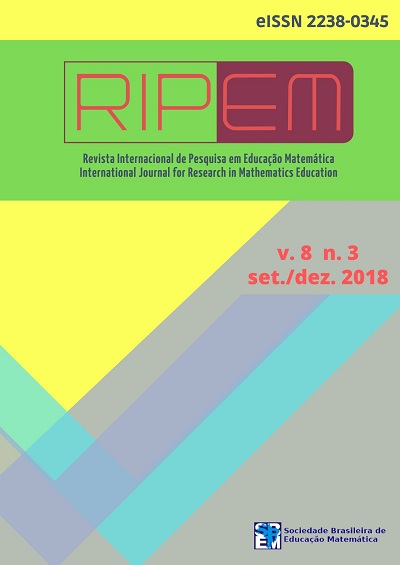Discovering the Pythagorean Theorem using the GeoGebra software
Keywords:
Mathematics Education, Pythagorean Theorem, Dialogues, GeoGebra, Humans-With-MediaAbstract
This paper presents some of the activities carried out during a Master’s study, in which the role of digital technologies was investigated in a group of humans-with-media for the production of knowledge about the Pythagorean Theorem. The research subjects were elementary school students. This qualitative study is theoretically based on the construct of humans-with-media, and the role of dialogue is defined as a conversation that aims at learning. The results indicate that the GeoGebra software contributed to the creation of a learning environment, which favored the students’ actions in the construction of mathematical knowledge and provided rich possibilities for the visualization of concepts and properties, enhanced by the dynamism of the trials from the constructions performed using GeoGebra.Downloads
References
Alro, H., & Skovsmose, O. (2010). Diálogo e Aprendizagem em Educação Matemática (2a. ed). (O. Figueiredo. Trad.). Belo Horizonte: Autêntica Editora.
Alro, H., & Skovsmose, O. (1996). On the right track. For the Learning of Mathematics, 16(1), 2-9 and 22.
Araújo, J. L. (2002). Cálculo, Tecnologias e Modelagem Matemática: As Discussões dos Alunos. Tese de doutorado não publicada, UNESP- Rio Claro, São Paulo, Brasil.
Araújo, J. L. (2004). Um diálogo sobre comunicação na sala de aula de matemática. Veritati, Salvador, 4, 81-93.
Arcavi, A. (2015). Revisiting aspects of visualisation in mathematics education. La Matematica Nella Società E Nella Cultura – Rivista della Unione Matematica Italiana. Serie I, VIII (3), 143-160. ISSN 1972-7356
Bairral, M. A. (2015). Licenciados em matemática analisando o comportamento de pontos notáveis de um triângulo em um ambiente virtual com GeoGebra. Anais da Reunião CientÃfica da ANPEd, Florianópolis, SC, Brasil, 37.
Borba, M. C. (2001). Coletivos Seres-humanos-com-mÃdias e a Produção de Matemática. Anais do Simpósio Brasileiro de Psicologia da Educação Matemática, Curitiba, PR, Brasil, 1.
Borba, M. C. (2011, 26-30 junho). Educação Matemática a Distância Online: Balanço e perspectivas. Anais do CIAEM-IACME, Recife, Brasil, 13.
Borba, M. C., & Villarreal, M. E. (2005). Humans-with-Media and Reorganization of Mathematical Thinking: Information and Communication Technologies, Modeling, Visualization and Experimentation. New York: Springer Science Business Media, Inc..
Carvalho, C. (2009). Comunicações e interações sociais na sala de aula de Matemática. In A. Nacarato, & C. Lopes (Ed.). Escritas e leituras na educação matemática (pp. 15-34). Belo Horizonte: Autêntica.
Fonseca, M., Lopes, M., Barbosa, M., Gomes, M., & Dayrell, M.. (2011). O ensino de Geometria na Escola Fundamental. Autêntica: Belo Horizonte.
Goldenberg, E. P., Scher, D., & Feurzeig, N. (2008). What lies behind dynamic interactive Geometry software? In G.W. Blume, & M.K. Heid. (Ed.). Research on technology and the teaching and learning of mathematics: cases and perspectives (Vol. 2, pp. 53-88). Charlotte: Information Age.
Gravina, M. A. (1996, novembro). Geometria dinâmica: uma nova abordagem para o aprendizado da geometria. Anais do Simpósio Brasileiro de Informática na Educação (pp. 1-13), Belo Horizonte, Brasil, 7.
Guzmán, M. (2002, July 1-6). The role of visualisation in the teaching and learning of mathematical analysis. Proceedings of the International Conference on the Teaching of Mathematics at the Undergraduate Level (pp. 1-24.), Hersonissos, University of Crete, Greece, 2.
Lévy, P. (1993). As tecnologias da inteligência: o futuro do pensamento na era da informática. Rio de Janeiro: Editora 34.
Lévy, P. (1999). Cibercultura. São Paulo: Editora 34.
Martinho, M. H. (2007) Comunicação na sala de aula de matemática: um projecto colaborativo com três professoras do ensino básico. Tese de Doutorado não publicada, Departamento de Educação, Universidade de Lisboa, Lisboa, Portugal.
Olive, J. et al. (2010). Mathematical Knowledge and Practices Resulting from Access to Digital Technologies. In C. Hoyles, & J.-B. Lagrange (Ed.). Mathematics Education and Technology-Rethinking the Terrain. New ICMI Study Series (Vol. 13, pp. 131-177). Springer, Boston, MA: Springer.
Santos, V. M. (2009). Linguagens e comunicação na aula de Matemática. In A. Nacarato, A., & C. Lopes (Ed.). Escritas e leituras na educação matemática (pp. 117-125). Belo Horizonte: Autêntica.
Sette, P. F. (2013). A aula de matemática no Projeto UCA: o GeoGebra e o Teorema de Pitágoras. Dissertação de mestrado não publicada, Universidade Federal de Ouro Preto, Minas Gerais, Brasil.
Silva, G. H. G., & Penteado, M. G. (2013). Geometria dinâmica na sala de aula: o desenvolvimento do futuro professor de matemática diante da imprevisibilidade. Ciência & Educação, 19 (2), 279-292
Stylianides, G. J., & Stylianides, A. J. (2005). Validation of solutions of construction problems in Dynamic Geometry environments. International Journal of Computers for Mathematical Learning, 31-47.
Tikhomirov, O. K. (1981). The psychological consequences of computerization. In J.V. Wertsch (Ed.) The concept of activity in sovietic psychology (256-278). New York: M. E. Sharpe.
Villarreal, M. E.: Borba, M. C. (2010). Collectives of humans-with-media in mathematics education: notebooks, blackboards, calculators, computers and … notebooks throughout 100 years of ICMI. ZDM Mathematics Education, 42, 49–62.
Published
How to Cite
Issue
Section

This work is licensed under a Creative Commons Attribution-NonCommercial-ShareAlike 4.0 International License.








